Surface Crystallization of Barium Fresnoite Glass: Annealing Atmosphere, Crystal Morphology and Orientation
Abstract
:1. Introduction
2. Experimental Section
2.1. Samples
2.2. Methods
3. Results
3.1. Crystal Morphology
3.1.1. Ambient and Dry Air
3.1.2. Argon
3.1.3. Vacuum
3.2. Surface Topography
3.3. Crystal Orientation
3.3.1. Ambient and Dry Air
3.3.2. Argon
3.3.3. Vacuum
3.3.4. Comparison, Details and Cropped Datasets
4. Discussion
4.1. Crystal Morphology
4.2. Surface Topography
4.3. Crystal Orientation
5. Conclusions
Supplementary Materials
Author Contributions
Funding
Data Availability Statement
Acknowledgments
Conflicts of Interest
References
- Halliyal, A.; Bhalla, A.S.; Newnham, R.E.; Cross, L.E. Ba2TiGe2O8 and Ba2TiSi2O8 pyroelectric glass-ceramics. J. Mater. Sci. 1981, 16, 1023–1028. [Google Scholar] [CrossRef]
- Halliyal, A.; Bhalla, A.S.; Markgraf, S.A.; Cross, L.E.; Newnham, R.E. Unusual pyroelectric and piezoelectric properties of fresnoite (Ba2TiSi2O8) single crystal and polar glass-ceramics. Ferroelectrics 1985, 62, 27–38. [Google Scholar] [CrossRef]
- Markgraf, S.A.; Halliyal, A.; Bhalla, A.S.; Newnham, R.E.; Prewitt, C.T. X-ray structure refinement and pyroelectric investigation of fresnoite, Ba2TiSi2O8. Ferroelectrics 1985, 62, 17–26. [Google Scholar] [CrossRef]
- Ting, R.Y.; Halliyal, A.; Bhalla, A.S. Polar glass ceramics for sonar transducers. Appl. Phys. Lett. 1984, 44, 852–854. [Google Scholar] [CrossRef]
- Nagel, M.S. Phasen- und Texturanalyse Gerichteter, Durch Elektrochemisch Induzierte Keimbildung Hergestellter Fresnoit-Glaskeramiken. Ph.D. Thesis, Friedrich-Schiller-Universität, Jena, Germany, 2011. [Google Scholar]
- Toyohara, N.; Benino, Y.; Fujiwara, T.; Komatsu, T. Enhancement of second harmonic intensity in thermally poled ferroelectric nanocrystallized glasses in the BaO-TiO2-SiO2 system. Solid State Commun. 2006, 140, 299–303. [Google Scholar] [CrossRef]
- Masai, H.; Tsuji, S.; Fujiwara, T.; Benino, Y.; Komatsu, T. Structure and non-linear optical properties of BaO-TiO2-SiO2 glass containing Ba2TiSi2O8 crystal. J. Non-Cryst. Solids 2007, 353, 2258–2262. [Google Scholar] [CrossRef]
- Takahashi, Y.; Benino, Y.; Fujiwara, T.; Komatsu, T. Large second-order optical nonlinearities of fresnoite-type crystals in transparent surface-crystallized glasses. J. Appl. Phys. 2004, 95, 3503–3508. [Google Scholar] [CrossRef]
- Kimura, M.; Fujino, Y.; Kawamura, T. New piezoelectric crystal: Synthetic fresnoite (Ba2Si2TiO8). Appl. Phys. Lett. 1976, 29, 227–228. [Google Scholar] [CrossRef]
- Osman, R.A.M.; Idris, M.S. Electrical properties of fresnoite Ba2TiSi2O8 using impedance spectroscopy. Adv. Mater. Res. 2013, 795, 640–643. [Google Scholar] [CrossRef]
- Wisniewski, W.; Thieme, K.; Rüssel, C. Fresnoite glass-ceramics—A review. Prog. Mater. Sci. 2018, 98, 68–107. [Google Scholar] [CrossRef]
- Keding, R. Elektrolytisch Induzierte Keimbildung in Schmelzen Dargestellt anhand der Gerichteten Kristallisation von Fresnoit. Ph.D. Thesis, Friedrich-Schiller-Universität, Jena, Germany, 1997. [Google Scholar]
- Keding, R.; Rüssel, C. Oriented glass-ceramics containing fresnoite prepared by electrochemical nucleation of a BaO-TiO2-SiO2-B2O3 melt. J. Non-Cryst. Solids 2000, 278, 7–12. [Google Scholar] [CrossRef]
- Höche, T.; Keding, R.; Rüssel, C.; Hergt, R. Microstructural characterization of grain-oriented glass-ceramics in the system Ba2TiSi2O8-SiO2. J. Mater. Sci. 1999, 34, 195–208. [Google Scholar] [CrossRef]
- Keding, R.; Rüssel, C. Electrochemical nucleation for the preparation of oriented glass ceramics. J. Non-Cryst. Solids 1997, 219, 136–141. [Google Scholar] [CrossRef]
- Honma, T.; Komatsu, T.; Benino, Y. Patterning of c-axis-oriented Ba2TiX2O8 (X = Si, Ge) crystal lines in glass by laser irradiation and their second-order optical nonlinearities. J. Mater. Res. 2008, 23, 885–888. [Google Scholar] [CrossRef]
- Honma, T.; Ihara, R.; Benino, Y.; Sato, R.; Fujiwara, T.; Komatsu, T. Writing of crystal line patterns in glass by laser irradiation. J. Non-Cryst. Solids 2008, 354, 468–471. [Google Scholar] [CrossRef]
- Wisniewski, W.; Nagel, M.; Völksch, G.; Rüssel, C. Electron Backscatter Diffraction of Fresnoite Crystals Grown from the Surface of a 2BaO3· TiO2·3 2.75SiO2 Glass. Cryst. Growth Des. 2010, 10, 1414–1418. [Google Scholar] [CrossRef]
- Ochi, Y.; Meguro, T.; Kakegawa, K. Orientated crystallization of fresnoite glass-ceramics by using a thermal gradient. J. Eur. Ceram. Soc. 2006, 26, 627–630. [Google Scholar] [CrossRef]
- Patschger, M.; Wisniewski, W.; Rüssel, C. Piezoelectric glass-ceramics produced via oriented growth of Sr2TiSi2O8 fresnoite: Thermal annealing of surface modified quenched glasses. CrystEngComm 2012, 14, 7368–7373. [Google Scholar] [CrossRef]
- Müller, R.; Zanotto, E.D.; Fokin, V.M. Surface crystallization of silicate glasses: Nucleation sites and kinetics. J. Non-Cryst. Solids 2000, 274, 208–231. [Google Scholar] [CrossRef]
- Reinsch, S.; Müller, R. Nucleation at silicate glass surfaces. In Analysis of the Composition and Structure of Glass and Glass Ceramics; Springer: Berlin, Germany, 1999; pp. 379–398. [Google Scholar]
- Wisniewski, W.; Rüssel, C. Oriented surface nucleation in inorganic glasses—A review. Prog. Mater. Sci. 2021, 118, 100758. [Google Scholar] [CrossRef]
- Wisniewski, W.; Saager, S.; Böbenroth, A.; Rüssel, C. Experimental evidence concerning the significant information depth of electron backscatter diffraction (EBSD). Ultramicroscopy 2017, 173, 1–9. [Google Scholar] [CrossRef] [PubMed]
- Otto, K.; Wisniewski, W.; Rüssel, C. Growth mechanisms of surface crystallized diopside. CrystEngComm 2013, 15, 6381–6388. [Google Scholar] [CrossRef]
- Wisniewski, W.; Otto, K.; Rüssel, C. Oriented Nucleation of Diopsode Crystals in Glass. Cryst. Growth Des. 2012, 12, 5035–5041. [Google Scholar] [CrossRef]
- Tielemann, C.; Busch, R.; Reinsch, S.; Patzig, S.; Höche, T.; Avramov, I.; Müller, R. Oriented surface nucleation in diopside glass. J. Non-Cryst. Solids 2021, 562, 120661. [Google Scholar] [CrossRef]
- Wisniewski, W.; Takano, K.; Takahashi, Y.; Fujiwara, T.; Rüssel, C. Microstructure of transparent strontium fresnoite glass-ceramics. Sci. Rep. 2015, 5, 9069. [Google Scholar] [CrossRef] [PubMed] [Green Version]
- Wisniewski, W.; Patschger, M.; Murdzheva, S.; Thieme, C.; Russel, C. Oriented Nucleation of both Ge-Fresnoite and Benitoite/BaGe4O9 during the Surface Crystallisation of Glass Studied by Electron Backscatter Diffraction. Sci. Rep. 2016, 6, 20125. [Google Scholar] [CrossRef]
- Wisniewski, W.; Bocker, C.; Kouli, M.; Nagel, M.; Rüssel, C. Surface crystallization of fresnoite from a glass studied by hot stage scanning electron microscopy and electron backscatter diffraction. Cryst. Growth Des. 2013, 13, 3794–3800. [Google Scholar] [CrossRef]
- Wisniewski, W.; Döhler, F.; Rüssel, C. Oriented Nucleation and Crystal Growth of Ba-Fresnoite (Ba2TiSi2O8) in 2 BaO·TiO2·2 SiO2 Glasses with Additional SiO2. Cryst. Growth Des. 2018, 18, 3202–3208. [Google Scholar] [CrossRef]
- Kracker, M.; Zscheckel, T.; Thieme, C.; Thieme, K.; Höche, T.; Rüssel, C. Morphology, topography, and crystal rotation during surface crystallization of BaO/SrO/ZnO/SiO2 glass. CrystEngComm 2019, 21, 1320–1328. [Google Scholar] [CrossRef]
- Cabral, A.A.; Fokin, V.M.; Zanotto, E.D.; Chinaglia, C.R. Nanocrystallization of fresnoite glass. I. Nucleation and growth kinetics. J. Non-Cryst. Solids 2003, 330, 174–186. [Google Scholar] [CrossRef]
- Rodrigues, A.M.; Rivas Mercury, J.M.; Leal, V.S.; Cabral, A.A. Isothermal and non-isothermal crystallization of a fresnoite glass. J. Non-Cryst. Solids 2013, 362, 114–119. [Google Scholar] [CrossRef]
- Moore, P.B.; Louisnathan, S.J. The crystal structure of fresnoite, Ba2(TiO)Si2O7. Z. Krist. Cryst. Mater. 1969, 130, 438–448. [Google Scholar]
- FIZ Karlsruhe. ICSD (Inorganic Crystal Structure Database). Available online: https://icsd.products.fiz-karlsruhe.de/en/about/about-icsd (accessed on 31 July 2015).
- D’Souza, A.S.; Pantano, C.G. Mechanisms for silanol formation on amorphous silica fracture surfaces. J. Am. Ceram. Soc. 1999, 82, 1289–1293. [Google Scholar] [CrossRef]
- Olsen, D.A.; Osteraas, A.J. The Critical Surface Tension of Glass. J. Phys. Chem. 1964, 68, 2730–2732. [Google Scholar] [CrossRef]
- Jebsen-Marwedel, H.; Brückner, R. Glastechnische Fabrikationsfehler. “Pathologische” Ausnahmezustände des Werkstoffes Glas und Ihre Behebung; Eine Brücke Zwischen Wissenschaft Technologie und Praxis; Springer: Berlin, Germany, 1980. [Google Scholar]
- Diaz-Mora, N.; Zanotto, E.D.; Hergt, R.; Müller, R. Surface crystallization and texture in cordierite glasses. J. Non-Cryst. Solids 2000, 273, 81–93. [Google Scholar] [CrossRef]
- Müller, R.; Reinsch, S. Viscous phase silicate processing. Process. Approaches Ceram. Compos. 2012, 3, 75–144. [Google Scholar]
- Komatsu, T.; Honma, T. Laser patterning and growth mechanism of orientation designed crystals in oxide glasses: A review. J. Solid State Chem. 2019, 275, 210–222. [Google Scholar] [CrossRef]
- Tielemann, C.; Reinsch, S.; Maaß, R.; Deubener, J.; Müller, R. Internal nucleation tendency and crystal surface energy obtained from bond energies and crystal lattice data. J. Non-Cryst. Solids X 2022, 14, 100093. [Google Scholar] [CrossRef]


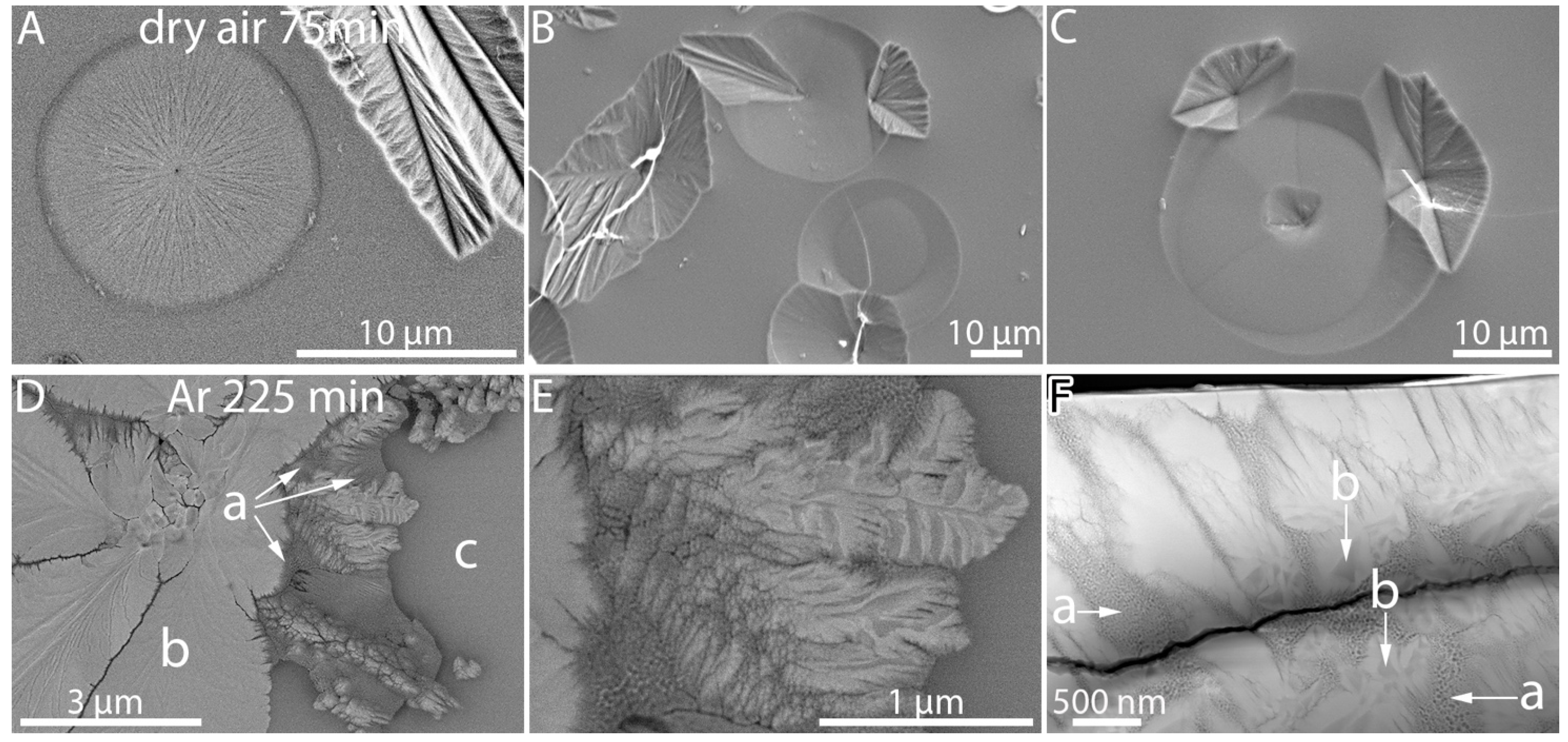
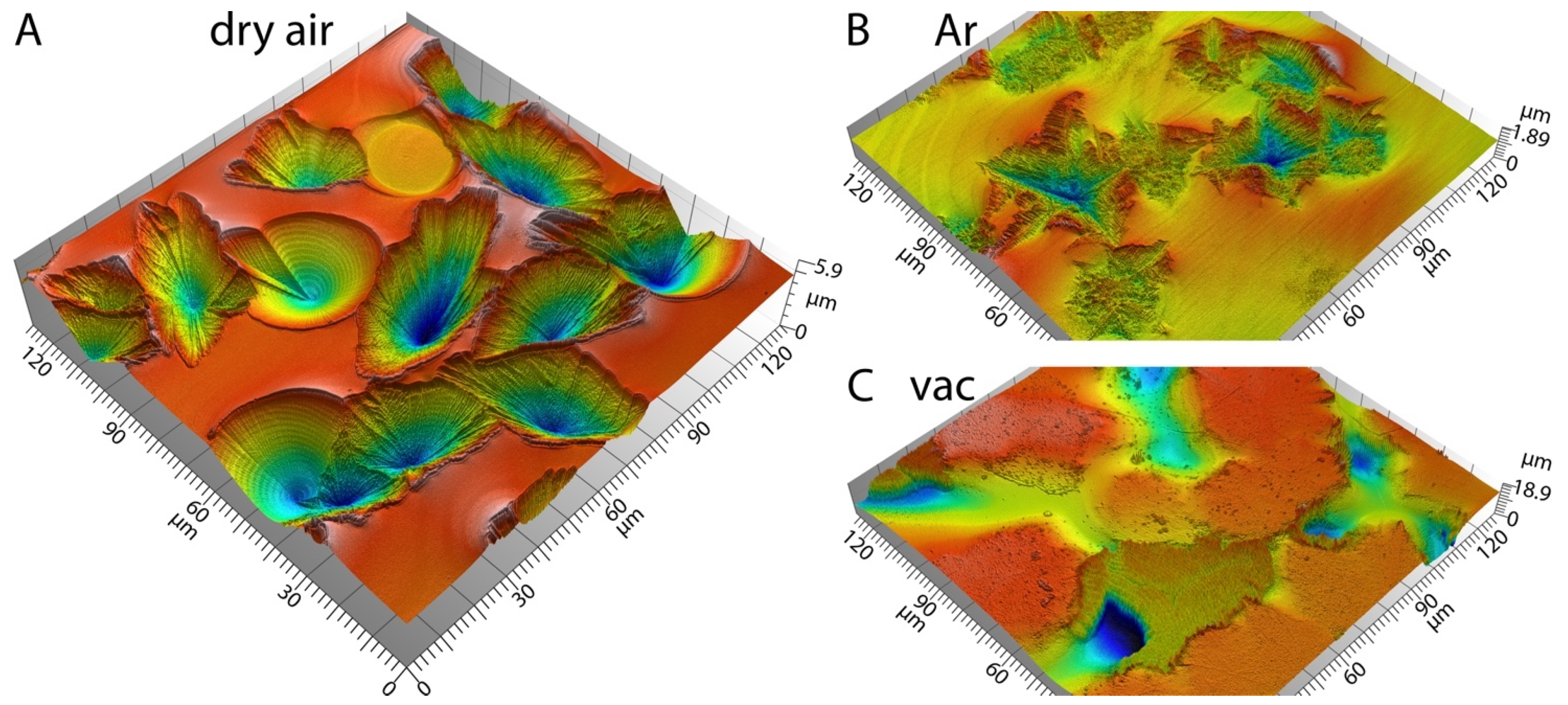
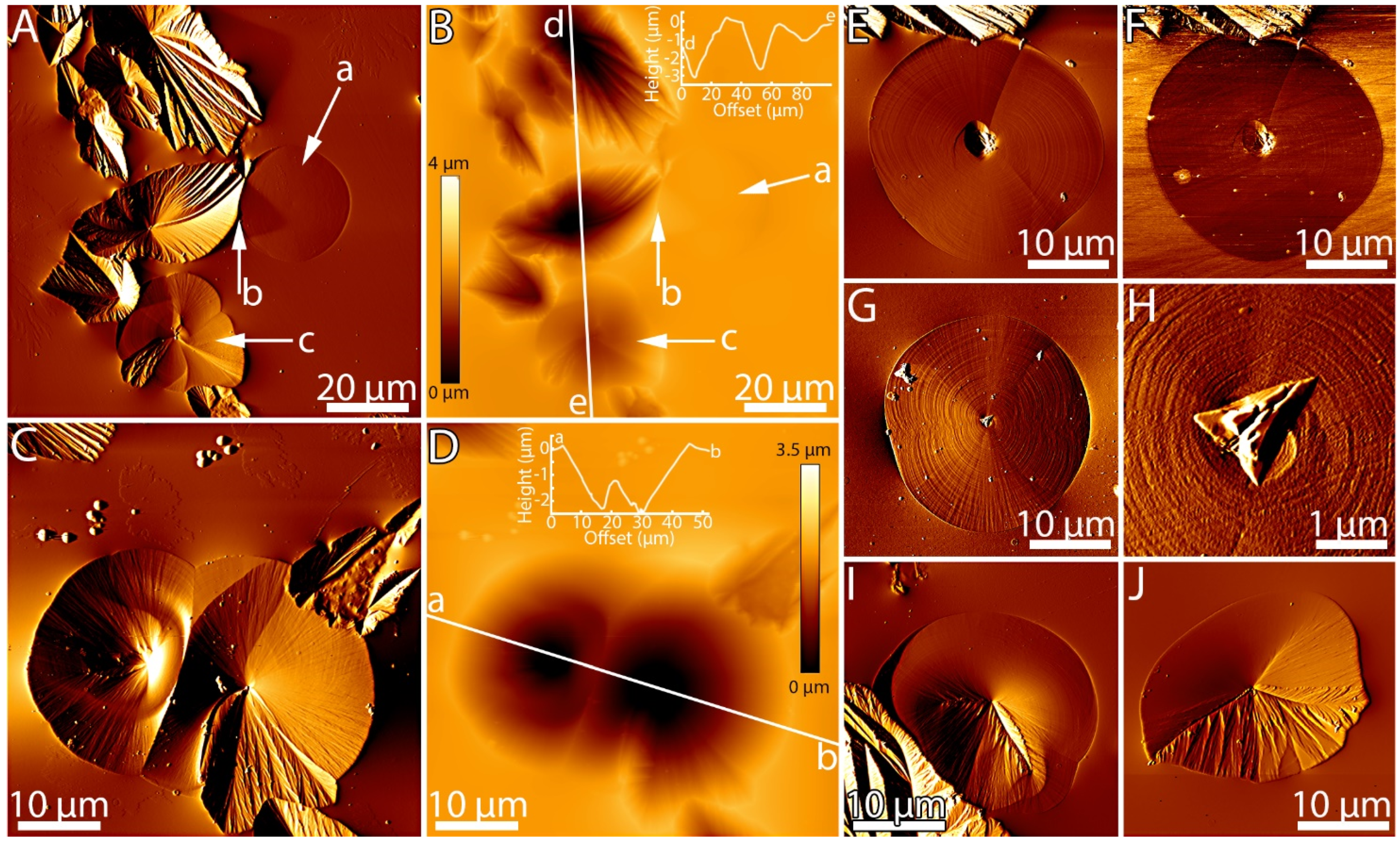
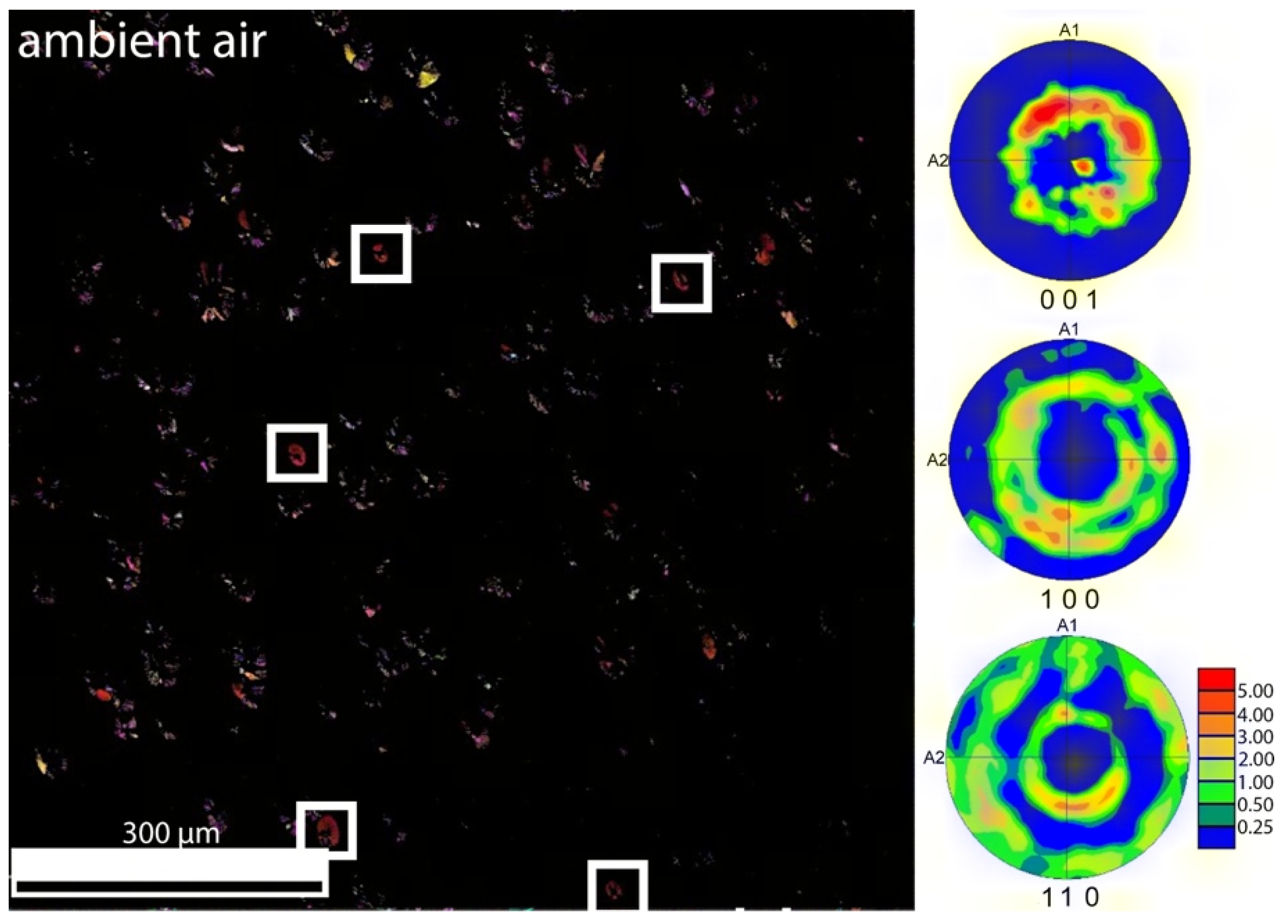

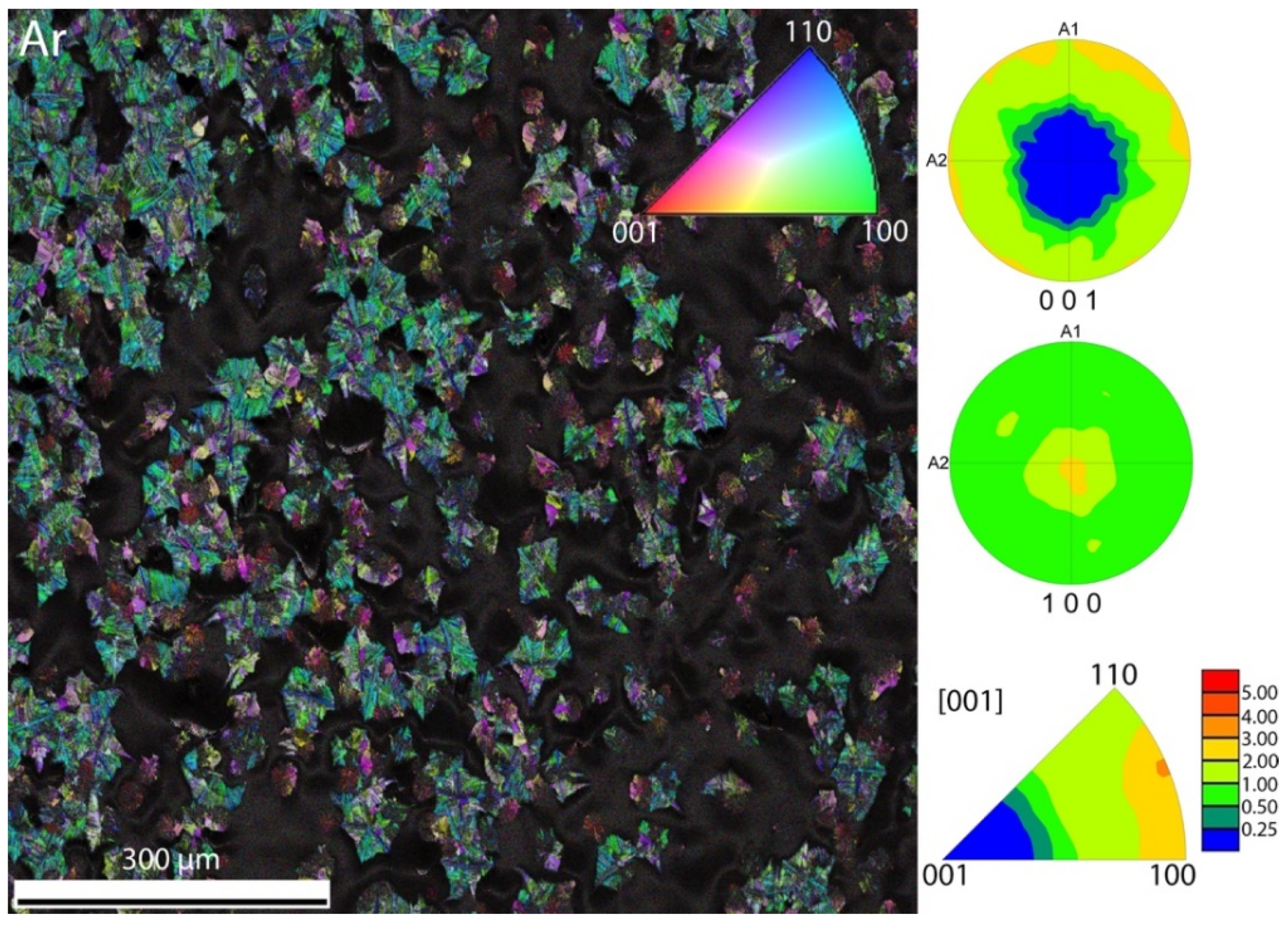
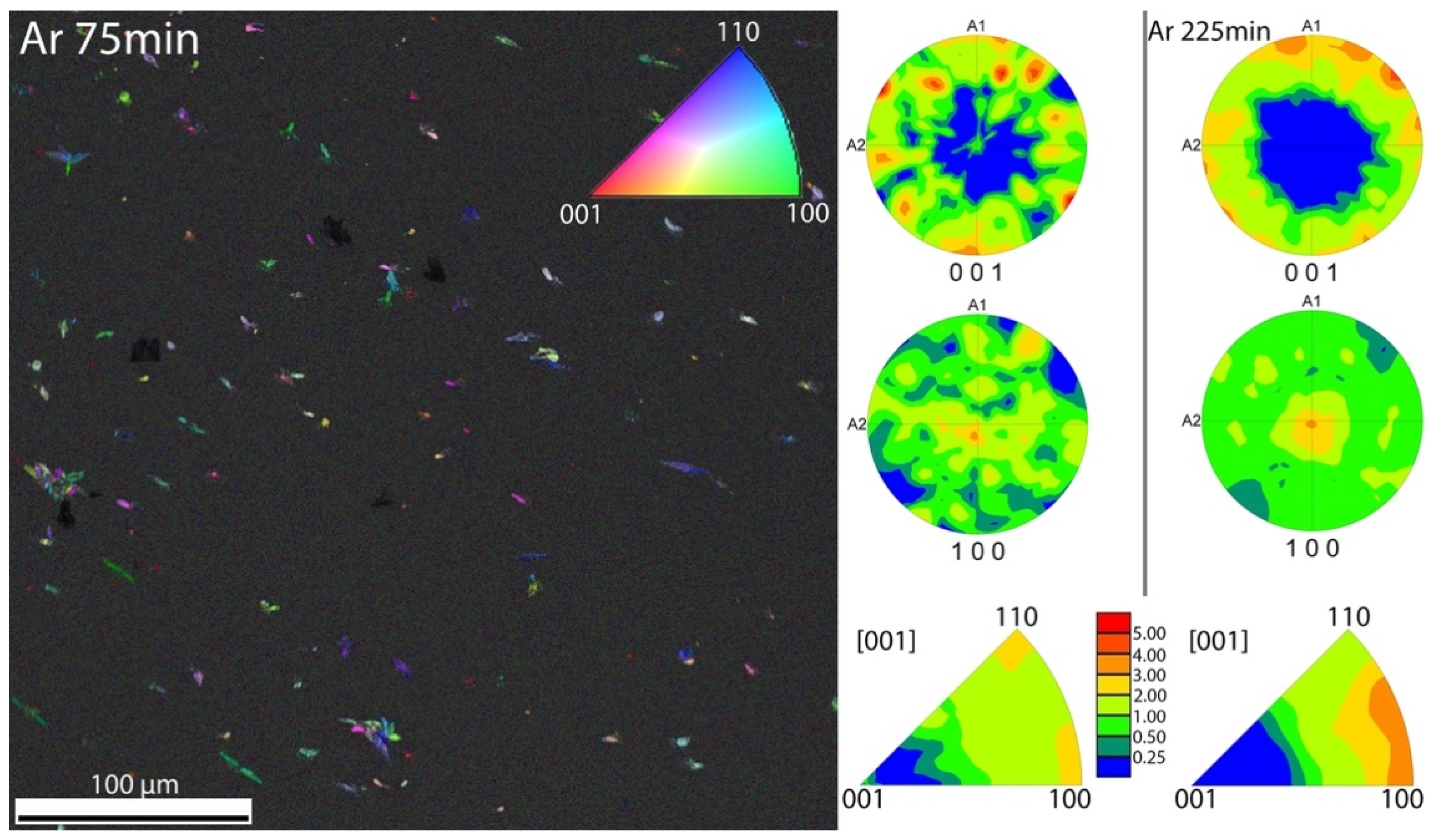



Disclaimer/Publisher’s Note: The statements, opinions and data contained in all publications are solely those of the individual author(s) and contributor(s) and not of MDPI and/or the editor(s). MDPI and/or the editor(s) disclaim responsibility for any injury to people or property resulting from any ideas, methods, instructions or products referred to in the content. |
© 2023 by the authors. Licensee MDPI, Basel, Switzerland. This article is an open access article distributed under the terms and conditions of the Creative Commons Attribution (CC BY) license (https://creativecommons.org/licenses/by/4.0/).
Share and Cite
Scheffler, F.; Fleck, M.; Busch, R.; Casado, S.; Gnecco, E.; Tielemann, C.; Brauer, D.S.; Müller, R. Surface Crystallization of Barium Fresnoite Glass: Annealing Atmosphere, Crystal Morphology and Orientation. Crystals 2023, 13, 475. https://doi.org/10.3390/cryst13030475
Scheffler F, Fleck M, Busch R, Casado S, Gnecco E, Tielemann C, Brauer DS, Müller R. Surface Crystallization of Barium Fresnoite Glass: Annealing Atmosphere, Crystal Morphology and Orientation. Crystals. 2023; 13(3):475. https://doi.org/10.3390/cryst13030475
Chicago/Turabian StyleScheffler, Franziska, Mirjam Fleck, Richard Busch, Santiago Casado, Enrico Gnecco, Christopher Tielemann, Delia S. Brauer, and Ralf Müller. 2023. "Surface Crystallization of Barium Fresnoite Glass: Annealing Atmosphere, Crystal Morphology and Orientation" Crystals 13, no. 3: 475. https://doi.org/10.3390/cryst13030475
APA StyleScheffler, F., Fleck, M., Busch, R., Casado, S., Gnecco, E., Tielemann, C., Brauer, D. S., & Müller, R. (2023). Surface Crystallization of Barium Fresnoite Glass: Annealing Atmosphere, Crystal Morphology and Orientation. Crystals, 13(3), 475. https://doi.org/10.3390/cryst13030475








